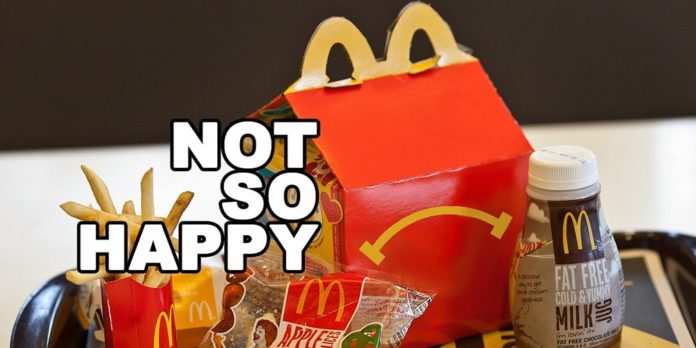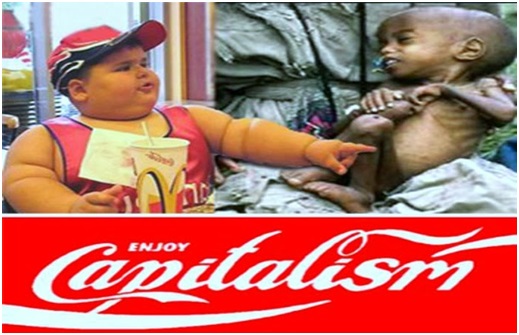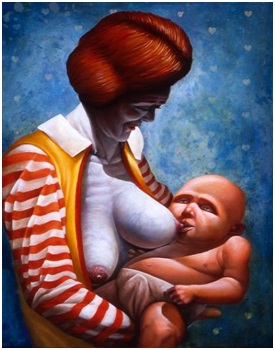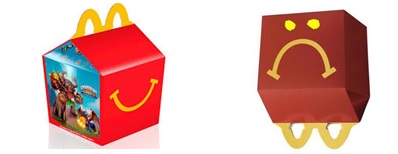
Written by: James Murray (via eMail submission)
The Happy Meal (HM), what a creation to consume. Targeting families, this McDonaldisation of food has seen supposed happiness brought to dinner tables all over the world. This blog will be considering and exploring how the minds of the likes of Lacan, Zizek and various other academics could ad to the discussion on HM’s. Other bloggers also enter into it, especially with their poignant use of images relating to McDonald’s.
Pass me another glass of coke will you? Thanks.
Looking through a lens of fetishism, we can view capitalism as a system of enjoyment, or as Lacan described it, jouissance(Böhm, Batta, 2010). From such a system, more is always required, and how apt that the common beverage served with a HM is coke, which doesn’t quench thirst, it dehydrates the consumer so more is desired (Gentile, McCaw, Fagan, Julie, 2012).Also, Coca-Cola, whose catchphrase of ‘enjoy’ has become part of anti-capitalist sentiment all over the world. 
Would you like to super-size that?
With a more health conscious (McPhail, Chapman, Beagan, 2011) and socially aware society (Young, Hwang, McDonald, Oates, 2010), McDonalds has had to change tact over time and adapt to the guilt involved of people consuming their products (Molz, 2005). The movie “Super-size me” is seen to have a beneficial effect for unaware consumers about the risks of over consumption of fast-food(Cottone, Byrd-Bredbenner, 2007). With the introduction of apples as an option in HM’s, McDonald’s has become the number one buyer of apples in the United States (Adams, 2007). Here we see “cultural capitalism” in effect (Rifkin, as cited in Zizek, 2014), as the apple, a representation of a healthy alternative, is ordered to replace the unhealthy french-fries. Commodity fetishism is visible once again, as the exploitation of natural resources involved in the production, transportation and packaging is ignored upon purchasing the product. Choice in our consumer society is of course an option, however marketing experts make a living from manipulatingconsumers, especially children, though not as dramatically as Ronald is in this next picture. 
An unholy alliance.
With McDonald’s struggling for dinner customers in its early years, their marketing team targeted families with the creation of the HM, and in particular, children (Schor, 2004). With Coca-Cola and McDonald’s already being business partners for some years, it was when Disney joined in 1996 (Weber, Chathoth, 2008) that an all powerful and unholy trio was formed. In order to achieve profit, following the logic of capital, McDonalds alliance with Disney led to the production of toys in Vietnam, which exploited labour there (Kincheloe, 2002). During 1997, over two hundred workers fell ill due to exposure to hazardous chemicals, while being paid $4.20 for a seventy-hour working week (Kincheloe). This unwanted ingredient is processed out of the ‘meal’ and replaced with fats and sugars to make it palatable (Cremin, 2011). Commodity fetishism has taken hold here, as the consumer becomes oblivious to the roles played by workers from behind the veil of exploitation that McDonalds has created (Hudson, Hudson, 2003). Some consumers are aware of the manipulation at hand and this is shown by a lawsuit against McDonald’s, which demanded toys be removed from HM’s (Olson, 2012).
Memory lane.
My first memorable HM toys were in the form of menu items, such as fries, a drink, or a burger, that transformed into robots (exploiting my pop. culture obsession at the time, Transformers). Now I see the toys as analogies for the workers who produced and served them to me, merely robots in the production line.I’m pretty sure fun doesn’t taste like exploitation, and if it does, it leaves a foul taste in my mouth and gives me indigestion. Here are the toys as they came.
Can I please have one unhappy meal?
The age of the HM seems coincidentally related to an age where depression and anxiety are particularly prescribed illnesses, especially in the United States (Grohol, 2011). Zizek (2014) highlighted this aspect, saying that our hedonism is juxtaposed with what is happening in our reality. We’re told that we should do whatever makes us happy. Here kids, says Ronald McDonald, don’t have an unhappy meal, have a happy meal. However, this is Ronald talkingwith dollar signs in his eyes. As we objectively observe human behaviour, we’re aware that increasing levels of consumption do not correlate with increasing levels of happiness (McDonald, 2004). The purchase of a HM is analogous to consumer culture in general. We as consumers seek fulfilment, satisfaction and happiness through the purchase of goods and services (Makant, 2010), yet can often be left wondering why we still feel so unfulfilled. This feeling of not being fulfilled may be part of the surplus that’s remaining in the formula for capital, as it’s never satisfied and always seeking more(Zizek, 2006).
It’s time to wean you off.
There have been studies describing how even highly motivated and aware individuals who have weight issues will still consume fast-food due to it’s addictive nature (Appelhans, Whited, Schneider, Pagoto, 2011). Targeting children, such as HM’s do, can set a trend for life long addiction, especially where outlets are geographically convenient, and prices are low, therefore being accessible and inviting to low socio-economic groups (Inagami, Cohen, Brown, Asch, 2009). Freud theorised the oral phase of development (Freud, 1957), maybe McDonald’s is the oral phase of development in terms of consumption of food outside the home for many families. The restaurant has been developed as somewhere acceptable for families to go and children to run amuck, with toys coming with the food and playgrounds often available. The child is no longer attached to the breast of the mother per se, but rather Ronald, who has replaced milk with Coca-Cola. 
Suckling on the teats of McDonald’s, an example of an organisation that’s thrived in capitalist driven societies. The willing and manipulated alike have been duped into believing some satisfaction, often in the way of happiness, will be provided from the products they offer. This satisfaction is short lived more often than not it seems, yet with it’s engineered addictiveness, we go back for more, until it’s realised that there are far better alternatives.
References
Adams, C. (2007). Reframing the obesity debate: McDonald’s role may surprise you. The Journal of Law, Medicine & Ethics, 35(1), 154-157.
Appelhans, B. M., Whited, M. C., Schneider, K. L., &Pagoto, S. L. (2011). Time to abandon the notion of personal choice in dietary counseling for obesity? Journal of the American Dietetic Association, 111(8), 1130.
Böhm, S., &Batta, A. (2010). Just doing it: enjoying commodity fetishism with Lacan. Organization, 17(3), 345-361.
Cottone, E., & Byrd-Bredbenner, C. (2007). Knowledge and Psychosocial Effects of the Film “Super Size Me” on Young Adults.Journal of the American Dietetic Association, 107(7), 1197-1203.
Cremin, C. (2011). Capitalism’s new clothes: enterprise, ethics and enjoyment in times of crisis. Pluto Pr.
Freud, S. (1957). The origins of psychoanalysis. Doubleday.
Gentile, S. L. K., McCaw, M. S., Fagan, C. R.,& Julie, M. (2012).Hazards to Caffeine in Energy Drinks and Healthy Alternatives.
Grohol, J. (2011). Top 25 Psychiatric Medication Prescriptions for 2011. Retrieved from http://psychcentral.com/lib/top-25-psychiatric-medication-prescriptions for-2011/00012586
Hudson, I., & Hudson, M. (2003). Removing the veil? Commodity fetishism, fair trade, and the environment.Organization & Environment, 16(4), 413-430.
Inagami, S., Cohen, D. A., Brown, A. F., & Asch, S. M. (2009). Body mass index, neighborhood fast food and restaurant concentration, and car ownership. Journal of Urban Health, 86(5), 683-695.
Jestem, K. (2013). Image 3: Enjoy Capitalism. Pogromcy I ObalaczeReklam. Retrieved from http://krytykareklamowa.blogspot.co.nz/2014/02/pogromcy-i obalacze-reklam.html
Kain, E. (2013). Image 1: Happy Meal. ‘Skylanders’ Action Figures Head To a Happy Mean Near You. Retrieved from http://www.forbes.com/sites/erikkain/2013/04/18/skylanders-action-figures head-to-a-happy-meal-near-you/
Kincheloe, J. L. (2002). The Sign of the Burger: McDonald’s and the Culture of Power. Temple University Press.
Leilani, L. (2010). Images 4,5. Fat kids…and their Happy Meals. Retrieved from http://laceymichaelleilani.blogspot.co.nz/2010/06/fat-kids-and-their-happy meals.html
Makant, M. G. (2010). The pursuit of happiness: The virtue of consumption and the consumption of virtue. Dialog, 49(4), 291-299.
McPhail, D., Chapman, G. E., &Beagan, B. L. (2011). ” Too much of that stuff can’t be good”: Canadian teens, morality, and fast food consumption. Social science & medicine, 73(2), 301-307.
McDonald, R. (2004). Television, Materialism and Culture: An exploration of imported media and its implications for GNH. Journal of Bhutan studies, 11, 68.
Molz, J. G. (2005). Guilty pleasures of the Golden Arches: mapping McDonald’s in narratives of round‐the‐world travel. Emotional geographies, 63-76.
Olson, W. (2012). McDonald’s suit over Happy Meal toys by California mom Monet Parham new low in responsible parenting.
Pikdit. (2013). Image 6.Ronald McDonald breast-feeding. Retrieved from http://pikdit.com/i/ronald-mcdonald-breast-feeding/
Schor, J. (2004). Born to buy: The commercialized child and the new consumer culture. Simon and Schuster.
Weber, K., &Chathoth, P. K. (2008). Strategic alliances. Handbook of Hospitality Marketing Management, 501.
Yarbrough, S. (2010).Image 2: UnHappy Meal.Happy Meal Toy Ban. Retrieved from http://shannonyarbrough.com/tag/happy-meal-toy-ban/
Young, W., Hwang, K., McDonald, S., & Oates, C. J. (2010). Sustainable consumption: green consumer behaviour when purchasing products. Sustainable Development, 18(1), 20-31.
Zizek, S. (2001).The fragile absolute: or, why is the Christian legacy worth fighting for?Verso.
Zizek, S. (2006).The parallax view. Cambridge, MA: Mit Press.
Zizek, S. (2014).Fat-free chocolate and absolutely no smoking: why our guilt about consumption is all-consuming. Retrieved from http://www.theguardian.com/artanddesign/2014/may/21/prix-pictet photography-prize-consumption-slavoj-zizek#start-of-comments





